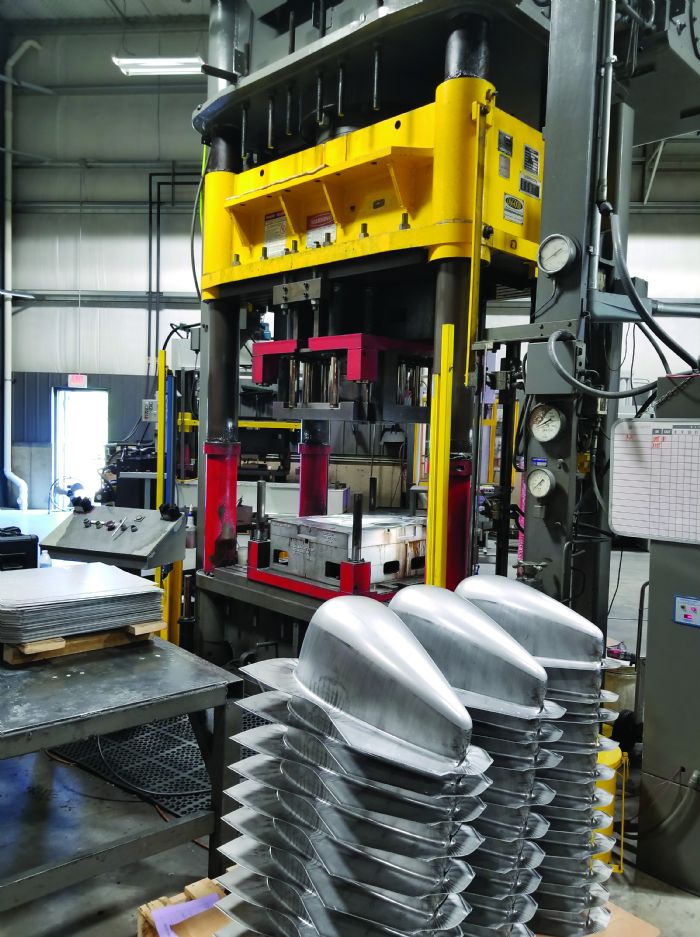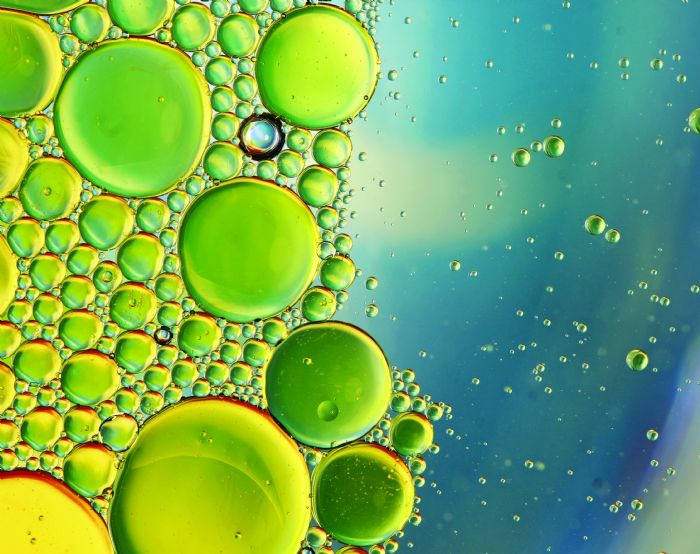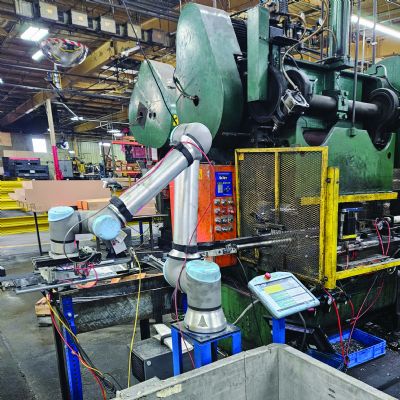 “I see a long-time trend toward semisynthetic, emulsion-based products,” says Marty Brunker, senior sales account manager at Univar Solutions, a specialty chemicals distributor, adding that semisynthetics prove much more versatile than either fully synthetic fluids or mineral-oil products. Fluid formulations using oil-soluble additives require an oil component, he also notes, and an oil film on the workpiece provides a barrier against corrosion.
“I see a long-time trend toward semisynthetic, emulsion-based products,” says Marty Brunker, senior sales account manager at Univar Solutions, a specialty chemicals distributor, adding that semisynthetics prove much more versatile than either fully synthetic fluids or mineral-oil products. Fluid formulations using oil-soluble additives require an oil component, he also notes, and an oil film on the workpiece provides a barrier against corrosion.
Chad Crocker, territory sales manager for S&S Chemical, also sees a long-term trend away from mineral oils toward semisynthetics with low to medium oil content. Severe operations such as deep drawing still require lubricity additives (i.e., chlorinated paraffins, especially longer-chain paraffins) that make some amount of oil and emulsifier necessary. However, lubricity additives have improved, offers Crocker, including good options such as esters and phosphate esters—fluid manufacturer Castrol moved on from chlorinated compounds many years ago, he adds, so it can be done. However, MWFs require a balance of different properties, and pricing remains a big factor.
“Right now,” Crocker says, “oil is cheaper than additives.”
Crocker mentions multiple projects over the past 15 yr. where companies developed MWFs using vegetable-based oils. However, he notes, the economic crash in 2008 and the COVID-19 pandemic halted many experimental projects for the next generation of MWFs. Another factor: fluctuations in petroleum prices, Crocker points out, as some MWFs can contain as much as 50 percent mineral oil.
Changes in Formulations
Oil-free fully synthetic fluids have a niche, according to Brunker, mostly for clean-running applications that don’t require a great deal of lubricity or long-term corrosion inhibition from the MWF. High speeds and low pressures are ideal for these fluids, he says. For instance, light grinding applications for metals such as cast iron or steel can employ synthetic fluids. However, the lack of an oil component limits the types of fluid additives available for use and the number of applications for a given formulation.
Brunker notes that the technology does not yet exist for lubricity additives and corrosion inhibitors for synthetic fluids to be used with higher-demand applications. Conversely, fully synthetic fluids more efficiently draw heat away from the cutting area because they do not contain high levels of solids that limit the cooling capacity of oil-containing fluids. Because synthetic fluids don’t often use surfactants or other additives that produce foam, they often don’t require antifoaming agents, and many of the lubricity components in synthetic fluids also help to reduce foaming, Brunker offers—another factor that makes these fluids attractive.
Indeed, some fluid manufacturers have moved on from certain antifoaming agents, including silicones and siloxanes, which can adhere to the workpiece and cause paint-adhesion problems.
“You see their formulations becoming very complex, using different raw materials to reduce the price and the potential for foam,” Brunker says.
Also, dilution-water quality varies from location to location, and even among different shops within a given area, thus a water-dilutable formulation that works in one shop might foam excessively in another. Reducing antifoaming agents in a formulation reduces costs and cuts down on the number of raw materials needed for the formulation.
Lower-oil systems tend to run cleaner, according to Crocker, as high-oil systems run under higher pressure, making them more likely to generate mist and foam. Even in enclosed systems, mists can settle on machines and workpieces, leaving residue when water evaporates. While most U.S. facilities employ mist guards and enclosures, facilities in some other parts of the world do not, making this a worker-health issue.
We also see movement toward biobased oils, but their biodegradability, attractive from a waste-disposal standpoint, also shortens MWF service life. Rapeseed and canola oil represent the most common vegetable-based oils for MWFs. However, according to Crocker, mineral oil is the best call for heavy-duty operations.
Light- to medium-duty applications can use fully synthetic fluids, but these formulations rely on water-soluble additives, meaning that they require different extreme-pressure additives than oil-soluble, emulsifiable additives such as chlorinated paraffins. For straight oils and semisynthetics, the oil component acts as both an additive carrier and a lubricant. Fully synthetic fluids—several are on the market—rely on additives to provide lubricity and water to act as coolant.
Oil-free fluids excel in resistance to microbial growth, notes Dubbert, with additives used in oil-free, synthetic MWFs providing far fewer nutrients than additives historically used in traditional soluble and semisynthetic fluids. This, in turn, reduces the level of biocides needed to protect the fluids. Reducing biocide usage represents a common concern, both for worker safety and for health and environmental considerations. In addition to direct hazards, concern exists over secondary hazards associated with biocides that release formaldehyde as they break down. However, Dubbert offers, these concerns are balanced by a need to keep fluids and machines free from microbial contamination, which also presents a worker hazard.
Semisynthetics, especially those with biobased components, require biocides. Vegetable-based fluids break down faster—good for disposal, but a disadvantage for operations. Because fully synthetic fluids run cleaner and act more biologically stable, fluid life runs longer, which reduces the amount of used fluid to be disposed. However, even “green” fluids can present disposal issues because used MWFs contain metal fines, tramp oil and everything else that finds its way into a sump.
Metals and alloys such as Inconel, titanium, compacted graphite iron, stainless steel, superalloy steels, 2000- or 7000-series aluminum and magnesium, as well as some composite materials, still require the lubricity of semisynthetics and soluble oils, according to Kook-Wha Koh, founder of Chrysan Industries, and difficult operations such as high-speed machining, deep drawing, broaching, roll tapping, stamping and fineblanking need oils.
Semisynthetic fluids and soluble oils may contain the same formulation components as fluids using mineral oils, offers Koh, thus if the cost difference is not prohibitive, semisynthetics can be substituted for mineral-oil formulations in many applications.
Environmental Considerations
|
MWF terminology varies among vendors and users. Here’s a guide to terminology used in this article:
|
Regulations on environmental protection and health and safety influence MWF ingredients, as do corporate initiatives geared toward sustainability and environmentally friendly practices. Brunker notes that over the past 10 to 15 yr., as the European Union (EU) banned several fluid additives commonly used for semisynthetics—some biocides and chlorinated lubricity additives in particular—it drove numerous operations back to using straight oils. Though less stringent than the EU, the United States is moving in this direction, with a focus more on versatility of applications, which tilts the balance toward semisynthetics.
One driver of greener formulations: what happens to an MWF after removal from service. Biodegradability represents a plus for fluid disposal, but “biodegradability goes both ways,” Brunker says.
A fluid that degrades while in service, resulting in a shorter service life, can drive up costs related to defective parts and higher volumes of fluid requiring disposal. Semisynthetic fluids contain soluble oils with anionic emulsifiers, sulfonates and corrosion inhibitors—generally simple for bacteria to break down. Because fully synthetic fluids contain fewer or none of these ingredients, they prove less prone to microbial contamination.
Brunker explains that more of his manufacturing customers ask about naturally derived products such as bioderived complex esters. About 15 yr. ago, he notes, began a push to use more vegetable oil-based emulsions, and some of these products still exist. However, vegetable oils are prone to bacterial attack. In addition, vegetable oils oxidize, which degrades the MWF and can produce varnish on metal tools and workpieces in high-temperature applications.
“It’s very difficult to formulate a product both biostable and biodegradable,” Brunker says.
Despite a trend toward more sustainability and fewer petroleum products in many industries, MWFs containing mineral oils provide performance and cost effectiveness, Dubbert says. When used and disposed of properly, these MWFs generally prove safe. With the rise of semisynthetic formulations, oil no longer represents 85 percent of the formulation. Instead, many concentrates include 10 to 20 percent oil, then diluted with water at 10:1 to 15:1.
More work is needed on waste treatment for oil-free fluids, according to Dubbert. The components that make these MWFs so stable also make them difficult to break down in a waste-treatment facility. Traditional waste-treatment methods (splitting or separating the MWF into water, oil and solids) do not effectively treat synthetic MWF solutions. Semisynthetics present similar problems. In addition, used MWF contains metal fines, machine oil and anything else that entered the system during operations, which means that dumping used fluid down the sewer is not an option without treatment, regardless of what a supplier implies, Dubbert says.
An Option: Minimum-Quantity Lubrication
Some operations take a different direction. Dry machining does away with MWFs entirely, using specially coated tools. Minimum-quantity lubrication (MQL) uses very small amounts of vegetable oil-based MWF sprayed onto the cutting area or applied as small droplets onto the tip of a tool.
Koh cautions that technological improvements are needed before MQL or dry machining can be used for more demanding applications such as stamping, deep drawing and fine blanking with stainless steel. These applications still require oil-containing MWFs, with associated procedures for fluid storage, maintenance and disposal. In addition, the oil film must be cleaned off of finished parts. However, Koh offers, even in conventional operations, newer tool coatings containing antiwear agents reduce the amount of MWF needed for certain applications.
The consensus among experts in the MWF industry: Technology for making fully synthetic fluids for the entire range of applications does not yet exist.
“I don’t see synthetics taking the whole market, there’s just no way,” Brunker says, noting that when choosing an MWF, “it becomes a question of what works best for you and what are the applications where you want to use it.”
Not only are mineral oils needed for high-demand applications, according to Crocker, but many products containing them have been around for years and users find them reliable.
Crocker’s assessment: “Mineral oil is here to stay.” MF
View Glossary of Metalforming Terms
See also: Society of Tribologists and Lubrication Engineers (STLE)
Technologies: Lubrication






 How far can metalworking-fluid (MWF) formulators push the trend toward less mineral-oil content—and less oil content of any kind? Over the past couple of decades, newer formulations on the market have trended toward less dependence on nonrenewable resources such as petroleum products and fewer ingredients such as biocides that pose worker-health concerns.
How far can metalworking-fluid (MWF) formulators push the trend toward less mineral-oil content—and less oil content of any kind? Over the past couple of decades, newer formulations on the market have trended toward less dependence on nonrenewable resources such as petroleum products and fewer ingredients such as biocides that pose worker-health concerns. 
 Video
Video
